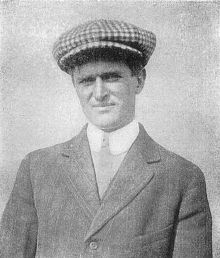Lincoln J. Beachey
| Lincoln J. Beachey | |
|---|---|
 |
|
| Born |
March 3, 1887 San Francisco, California |
| Died | March 14, 1915 (aged 28) Panama-Pacific International Exposition San Francisco, California |
| Cause of death | Aircrash |
| Resting place | Cypress Lawn Memorial Park |
| Occupation | Aviator |
| Parent(s) | William C. Beachey |
| Relatives | Hillary Beachey (1885–1964), brother |
Lincoln J. Beachey (March 3, 1887 – March 14, 1915) was a pioneer American aviator and barnstormer. He became famous and wealthy from flying exhibitions, staging aerial stunts, helping invent aerobatics, and setting aviation records.
He was known as The Man Who Owns the Sky, and sometimes the Master Birdman. Beachey was acknowledged even by his competitors as "The World's Greatest Aviator". He was "known by sight to hundreds of thousands and by name to the whole world".
Beachey was born on March 3, 1887, in San Francisco.
Following in his older brother Hillary's footsteps, he worked as a ground crewman for dirigible pilot Thomas Scott Baldwin. He helped build the dirigible California Arrow and made his first dirigible flight in 1905, at the age of 17. Later he helped design a faster, more aerodynamic dirigible known as the "Beachey-Baldwin".
In 1910 he piloted his Beachey-Knabenshue Racing Airship balloon at the 1910 Los Angeles International Air Meet at Dominguez Field, and raced fixed-wing aircraft around a course at an altitude of 100 feet (30 m). Meanwhile, his brother Hillary began flying aeroplanes at the meet (the Gill-Dosh Curtiss-type biplane), and soon began experimenting with such craft, too.
At the 1911 Los Angeles airshow, Beachey made the first successful recovery from an engine failure that caused his plane to go into a nose-diving spin from an altitude of over 3,000 feet. No previous pilot had survived a similar situation.
After that, Beachey joined the exhibition team of aviation pioneer Glenn Curtiss. Unfamiliar with Curtiss' designs, it is said he crashed three times while learning to fly them, but soon achieved mastery of this new design.
In June the organizers of the U. S.-Canadian Carnival offered $1,000 to the first person to fly an aeroplane over Niagara Falls. Beachey responded in his Curtiss D biplane, and on June 27, 1911, Beachey took off into a drizzle and flew over the lower falls of Niagara Falls, then above American Falls, before an estimated 150,000 spectators. While gradually climbing, Beachey circled his plane over the falls several times. After he completed this performance he dove down into the mists of the falls, within 6 meters (20 feet) of the surface of the Niagara River. Then he flew his plane under the Honeymoon Bridge 6 meters (20 feet) above the rapids and down the length of the Niagara Gorge. Local papers described his plane as looking like "a beat-up orange crate".
...
Wikipedia
